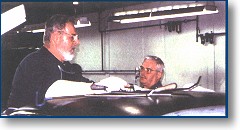 |
|
|
|
The
Classroom and Hands-On Training
|
||
Plastic Deformation:  When flat sheet metal is drawn or stamped into desired shapes/parts, the plastic properties of the metal allow it to do so without the metal breaking or splitting. This is plastic deformation. Because of the degree to which the plastic deformation of sheet metal must achieve soft grades of metal must be used. Harder grades of metal do not have the plastic deformation ability to withstand the forces necessary in stamped part fabrication. The plastic deformation of metal by tension is called "stretching". In sheet metal repairs, both the stretching and upsetting of the metal surfaces are involved.
Elasticity: Heat: [Top]
|
|
|
Home Page
|
Safety Procedures |
Tools & Procedures
|
Sheet
Metal |
|
Copyrightę 2001, 2002, UCI Advanced Metal Finish Training
All Rights Reserved
Phone: (502) 417-7009
E-mail:
msinger@metalfinishtraining.com
Best viewed at 800 x 600
Resolution